
Randolph Rogers was an American Neoclassical sculptor. An expatriate who lived most of his life in Italy, his works ranged from popular subjects to major commissions, including the Columbus Doors at the U.S. Capitol and American Civil War monuments.
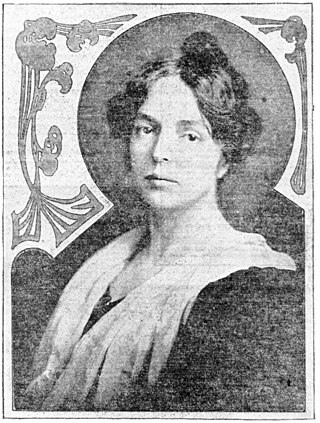
Theodora Alice Ruggles Kitson, known as Theo A.R. Kitson, was an American sculptor.
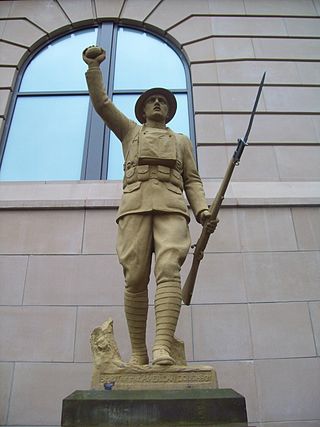
The Spirit of the American Doughboy is a pressed copper sculpture by E. M. Viquesney, designed to honor the veterans and casualties of World War I. Mass-produced during the 1920s and 1930s for communities throughout the United States, the statue's design was the most popular of its kind, spawning a wave of collectible miniatures and related memorabilia as well as numerous copies by other artists. Its title is often shortened to The Doughboy.

Allen George Newman III was an American sculptor, best known for his statue "The Hiker".
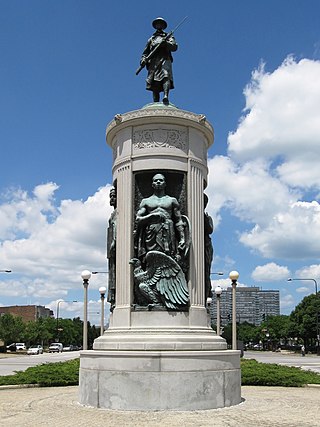
Erected in 1927, the Victory Monument, is a bronze and granite sculptural monument, based on a concept by John A. Nyden, and sculpted by Leonard Crunelle. It was built to honor the Eighth Regiment of the Illinois National Guard, an African-American unit that served with distinction in France during World War I. It may be the only memorial statue dedicated to African-American soldiers of the Great War.

Ernest Moore Viquesney was an American sculptor best known for his popular World War I monument Spirit of the American Doughboy.
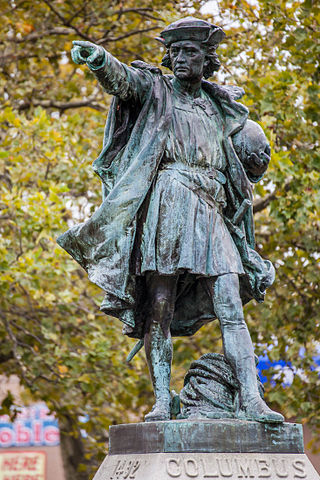
Columbus is a historic statue in Johnston, Rhode Island. The statue is a bronze cast of a sterling silver statue which was created by Rhode Island's Gorham Manufacturing Company for the 1892 World's Columbian Exposition in Chicago. The original silver statue was not meant for permanent exhibition, but rather as a demonstration of the skills of the Gorham Company, and was later melted down. The bronze cast was dedicated on November 8, 1893, in Columbus Square, in Providence, Rhode Island, United States as a gift from the Elmwood Association to the City of Providence.

Collyer Monument is an historic monument to firefighters in Mineral Spring Park, at the corner of Mineral Spring Avenue and Main Street, in Pawtucket, Rhode Island, United States. The monument was built in 1890 by the sculptor Charles Parker Dowler to honor Samuel Smith Collyer, a fallen Pawtucket Fire Chief. The life-size bronze sculpture stands atop a pedestal of Westerly granite, which has a bronze plaque depicting the fatal accident while the reverse bears an inscription. The memorial represents a significant example of monumental work of the period and an early example of local civic pride. The monument was added to the National Register of Historic Places in 1983.

Liberty Arming the Patriot, sometimes called Freedom Arming the Patriot, is a bronze sculpture at Park Place in Pawtucket, Rhode Island, commemorating the participation of the city's citizens in the American Civil War. It was designed by William Granville Hastings and cast by the Gorham Manufacturing Company in 1897. Unlike many Civil War memorials, Liberty Arming the Patriot is a dynamic composition, depicting a young farmer setting his plow aside, and reaching to take a sword from a classical female figure clad in breastplate and wielding a pike. The statue is 11 feet (3.4 m) in height, and is mounted on a granite base 10 feet (3.0 m) high and 22 feet (6.7 m) wide. The sculpture was listed on the National Register of Historic Places in 2001.

The John Paul Jones Memorial, also known as Commodore John Paul Jones, is a monument in West Potomac Park, Washington, D.C. The memorial honors John Paul Jones, the United States' first naval war hero, and received the Congressional Gold Medal after the American Revolutionary War ended. Jones allegedly said "I have not yet begun to fight!" during the Battle of Flamborough Head.

Burt William Johnson was an American sculptor.

Major General John A. Logan, also known as the General John A. Logan Monument and Logan Circle Monument, is an equestrian statue in Washington, D.C., that honors politician and Civil War general John A. Logan. The monument is sited in the center of Logan Circle, a traffic circle and public park in the Logan Circle neighborhood. The statue was sculpted by artist Franklin Simmons, whose other prominent works include the Peace Monument and statues in the National Statuary Hall Collection. The architect of the statue base was Richard Morris Hunt, designer of prominent buildings including the Metropolitan Museum of Art in New York City and The Breakers in Newport, Rhode Island. Prominent attendees at the dedication ceremony in 1901 included President William McKinley, members of his cabinet, Senator Chauncey Depew, Senator Shelby Moore Cullom, and General Grenville M. Dodge.

The General William Tecumseh Sherman Monument is an equestrian statue of American Civil War Major General William Tecumseh Sherman located in Sherman Plaza, which is part of President's Park in Washington, D.C., in the United States. The selection of an artist in 1896 to design the monument was highly controversial. During the monument's design phase, artist Carl Rohl-Smith died, and his memorial was finished by a number of other sculptors. The Sherman statue was unveiled in 1903. It is a contributing property to the Civil War Monuments in Washington, D.C. and to the President's Park South, both of which are historic sites listed on the National Register of Historic Places.
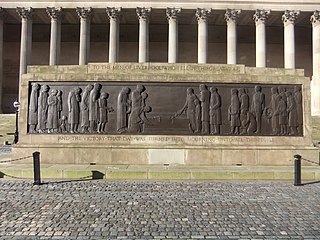
Liverpool Cenotaph stands on St George's Plateau, to the east of St George's Hall in Liverpool, England. It was erected as a memorial to those who had fallen in the First World War. The dates of the Second World War were subsequently added. The cenotaph consists of a rectangular block of stone on a stone platform, with bronze, low-relief sculptures on the sides depicting marching troops and mourners. It was designed by Lionel Budden, with carving by Herbert Tyson Smith. Initially designated as a Grade II listed building, its status was raised to Grade I in 2013.

The 107th Infantry Memorial is an outdoor bronze sculpture and memorial located at the intersection of East 67th Street and Fifth Avenue in Central Park, in Manhattan, New York, United States, which honors members of the 107th Infantry who died during World War I. Created by the sculptor Karl Morningstar Illava (1896–1954), who "drew from his own experience serving as a sergeant with the 107th," according to the New York City Department of Parks & Recreation, the sculpture cost an estimated $60,000 at the time of its construction, depicts the actions of seven World War I-era soldiers, and rests on a 25-foot-wide stepped granite base designed by architects Rogers & Haneman.

Pietro Montana was a 20th-century Italian-American sculptor, painter and teacher, noted for his war memorials and religious works.

Commodore Oliver Hazard Perry Monument is a war monument in Cleveland, Ohio that commemorates Oliver Hazard Perry and his victory at the Battle of Lake Erie in the War of 1812. Erected at the center of the city's Public Square in 1860, its Perry statue by sculptor William Walcutt was Ohio's first monumental sculpture.

Joseph Pasquale Pollia was an Italian-born American sculptor who created numerous monuments and war memorials.

The Lafayette Memorial is a public memorial located in Brooklyn's Prospect Park in New York City. The memorial, designed by sculptor Daniel Chester French and architect Henry Bacon, was dedicated in 1917 and consists of a bas-relief of Gilbert du Motier, Marquis de Lafayette alongside a groom and a horse.





















